Sandy Bridge-E and X79 – The ASUS P9X79 PRO Review
by Ian Cutress on November 14, 2011 3:01 AM EST- Posted in
- Motherboards
- Asus
- X79
USB Speed
For this benchmark, we run CrystalDiskMark to determine the ideal sequential read and write speeds for the USB port using our 64GB Patriot SuperSpeed USB 3.0 drive. Then we transfer a set size of files from the SSD to the USB drive, and monitor the time taken to transfer. The files transferred are a 1.52 GB set of 2867 files across 320 folders – 95% of these files are small typical website files, and the rest (90% of the size) are the videos used in the Sorenson Squeeze test.


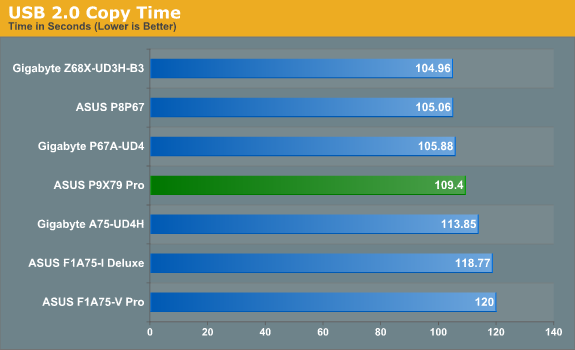
Unfortunately, we ran into an issue with our USB 3.0 stick after the USB 2.0 tests. For some reason it is no longer being detected properly. When we get a replacement, the graphs shall follow.
SATA Testing
We also use CrystalDiskMark for SATA port testing. The operating system is installed on the Micron RealSSD C300, which is rated at 355 MB/s read and 215 MB/s write, and the sequential test is run at the 5 x 1000 MB level. This test probes the efficiency of the data delivery system between the chipset and the drive, or in the case of additional SATA ports provided by a third party controller, the efficiency between the controller, the chipset and the drive.
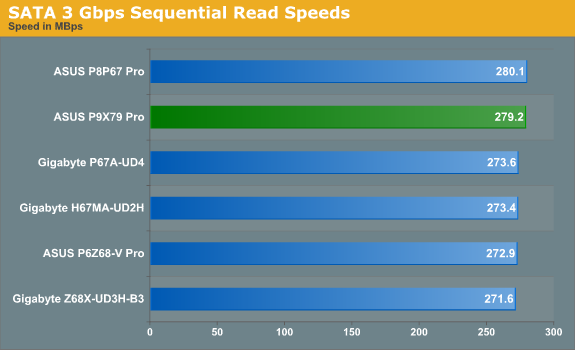
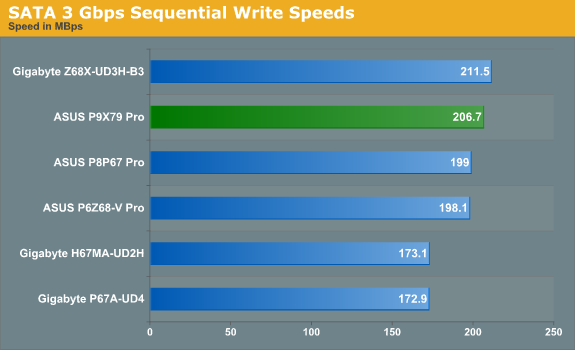
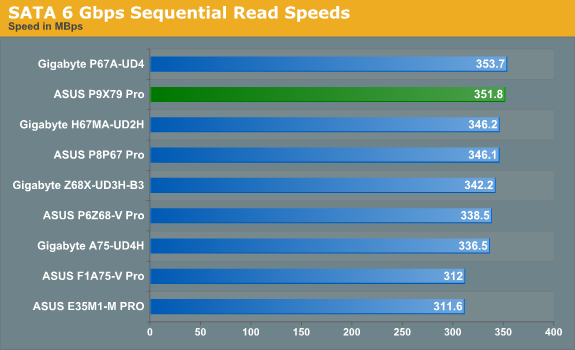
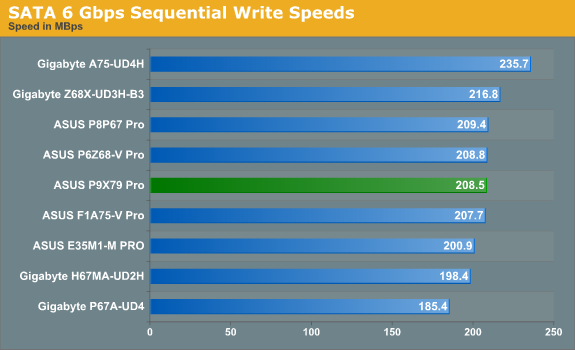
Overall, the PCH does well in SATA sequential speeds compared to previous platforms.
DPC Latency
Deferred Procedure Call latency is a way in which Windows handles interrupt servicing. In order to wait for a processor to acknowledge the request, the system will queue all interrupt requests by priority. Critical interrupts will be handled as soon as possible, whereas lesser priority requests, such as audio, will be further down the line. So if the audio device requires data, it will have to wait until the request is processed before the buffer is filled. If the device drivers of higher priority components in a system are poorly implemented, this can cause delays in request scheduling and process time, resulting in an empty audio buffer – this leads to characteristic audible pauses, pops and clicks. Having a bigger buffer and correctly implemented system drivers obviously helps in this regard. The DPC latency checker measures how much time is processing DPCs from driver invocation – the lower the value will result in better audio transfer at smaller buffer sizes. Results are measured in microseconds and taken as the peak latency while cycling through a series of short HD videos - under 500 microseconds usually gets the green light, but the lower the better.

As with the faster processor, we are expecting better DPC Latency as long as the system is engineered quickly. Our max result here was 116 microseconds, however this was a blip - for most of the time, the board would hover around 30 microseconds, which is an excellent result.










55 Comments
View All Comments
OblivionLord - Monday, November 14, 2011 - link
Better question... why use a dual 5850 setup to test a dual 16x pci-e 2.0 when you could have done a dual 5990 or better yet dual 590 or 6990? The main benefit with this release is to answer the lack of pci-e lanes which if you had highend cards, your only option was x58 until this release since dual 8x just wouldn't cut it on a dual 590 or dual 6990 solution.Also when running those cards in sli/crossfire, lets see how stressed the 4 core sb is vs the new 6 core or even nehalem or westmere.
Beenthere - Monday, November 14, 2011 - link
No disrespect to Asus but there's no way in Hell I'd pay $300 for any desktop mobo no matter how many "features" it has.In addition the X79 chipset with more RAM channels is a waste for anything but server use, which is not what this mobo/platform is being hyped for. As other website reviewers have noted, the X79 mobos are basically hacked server mobos being hyped as an enthusiast desktop upgrade, which it really is not.
With the price of the mobo and CPUs, Sandy Bridge-E and X79 are a fail as far as many if not most enthusiasts are concerned. Basically this is a rushed-to-market product that doesn't fit well in either the enthusiast or server segments. That's why many folks are saying: PASS just as they are with "Ultrabooks" that ain't Ultra at all except in price - just like this deal.
This deal looks like an opportunistic cash cow that may die quickly?
Mikuni - Monday, November 14, 2011 - link
Why anand never mentions in ASUS reviews about the long standing memory leak present in their AI suite? atkexComSvc grows up to a few GB after just a few days, this is totally unacceptable and should be made aware in every post and review about ASUS until they fix it.ASUSTechMKT - Wednesday, November 16, 2011 - link
Feel free to send me information i continually use this application and have not seen this issue. It is a possibility an attached driver or system could be causing the issue. Regardless we are interested into looking into it if there is an issue.
vol7ron - Monday, November 14, 2011 - link
Ian,I'm curious how this would fair for computational games like Starcraft II, which relies less on video rendering in FPS and more on model layouts.
Thx
mdzcpa1 - Monday, November 14, 2011 - link
I'm concerned to see the review says there is no long crossfire cable included. Obviously anyone wanting to run crossfire on this board and have the X16 X16 slots is going to need a long CF cable. Is it possible the reviewer is incorrect and the long ribbon cable is for CF?ASUSTechMKT - Wednesday, November 16, 2011 - link
The extended cable is SLI. As AMD cards include crosshair cables it is up to the vendor you purchase from to opt in those cables. On our triple slot cards we do offer a extended length cable. Regardless this is good feeback i will pass along to HQ but it is also another cost aspect to consider. As most of the dual GPU market uses SLI it was a decision made on that factor.On a secondary note we do have availible for pruchase extended crossfire bridges from our estore.
bradcollins - Tuesday, November 15, 2011 - link
Do your X79 boards support Xeon E5 series cpu's? I have a pair of E5-2670's here and I am trying to choose between the Gigabyte X79-UD5 and your P9X79 Deluxe. Because you have taken fan speed control seriously, I will most likely get the P9X79 Deluxe, but would like to know if it will support my cpu.Beenthere - Tuesday, November 15, 2011 - link
No disrespect but what's the big deal with fan control? I've been building high end PCs for 20 years and never had any issues with fan speed control.bradcollins - Tuesday, November 15, 2011 - link
There has never been a board that has automatically done what I want it todo, until now by the looks of that picture in this article. I want my pc to be silent during normal operation and don't care too much about the noise when I'm playing games. At the moment the loudest thing in my PC which is an i7 975EE at 3.73ghz is the hard drives, and I want my SB-E system to be just as quiet. With an E5-2670 at (hopefully) around 4.2ghz or so I am worried about how loud it will be.Ohh and by the way Asustechmkt, I did read this from an earlier post, but you don't specifically say if the other boards will boot or what will happen: "Our P9X79 WS is qualified to support Xeon series CPUs. Other baords may potentially offer microcode support but will not be officially validated for use with Xeon CPUs. "